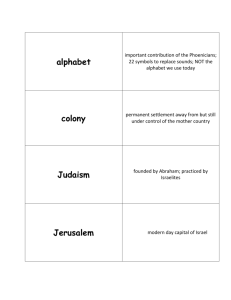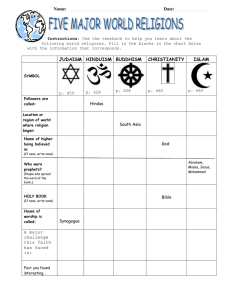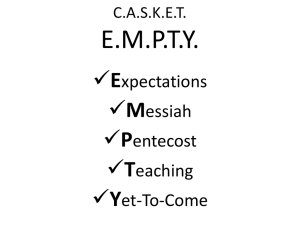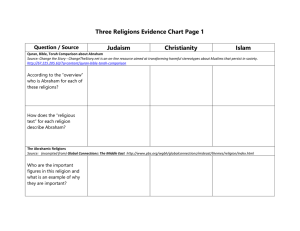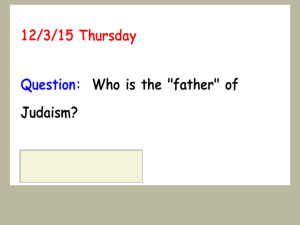First Century Judaism
advertisement
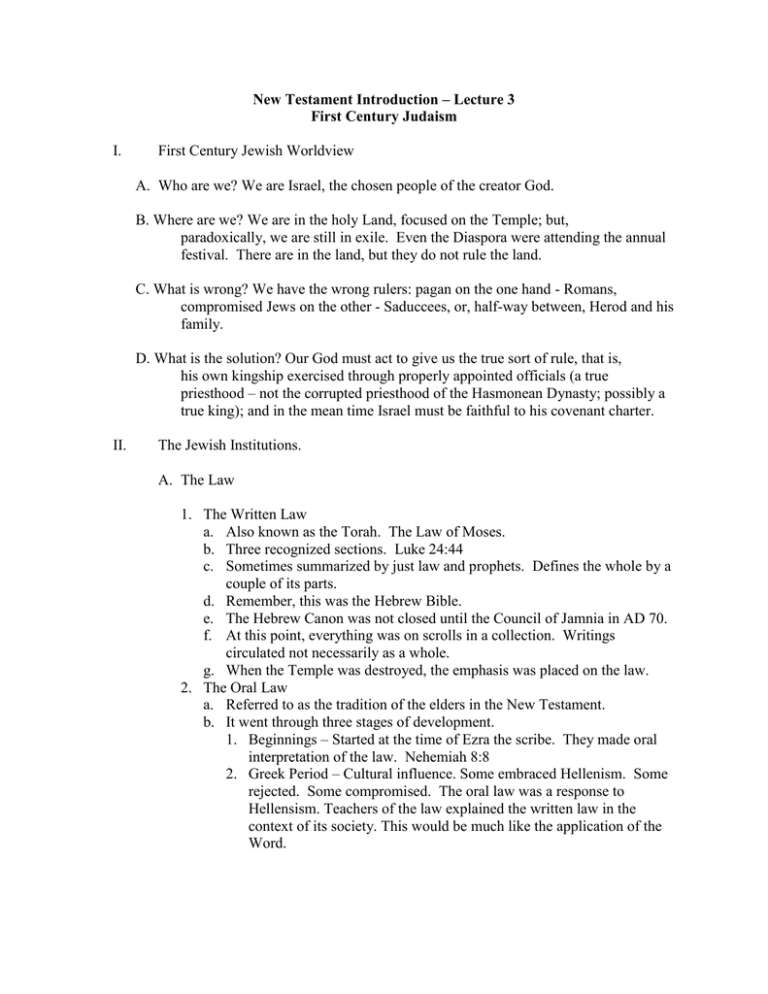
New Testament Introduction – Lecture 3 First Century Judaism I. First Century Jewish Worldview A. Who are we? We are Israel, the chosen people of the creator God. B. Where are we? We are in the holy Land, focused on the Temple; but, paradoxically, we are still in exile. Even the Diaspora were attending the annual festival. There are in the land, but they do not rule the land. C. What is wrong? We have the wrong rulers: pagan on the one hand - Romans, compromised Jews on the other - Saduccees, or, half-way between, Herod and his family. D. What is the solution? Our God must act to give us the true sort of rule, that is, his own kingship exercised through properly appointed officials (a true priesthood – not the corrupted priesthood of the Hasmonean Dynasty; possibly a true king); and in the mean time Israel must be faithful to his covenant charter. II. The Jewish Institutions. A. The Law 1. The Written Law a. Also known as the Torah. The Law of Moses. b. Three recognized sections. Luke 24:44 c. Sometimes summarized by just law and prophets. Defines the whole by a couple of its parts. d. Remember, this was the Hebrew Bible. e. The Hebrew Canon was not closed until the Council of Jamnia in AD 70. f. At this point, everything was on scrolls in a collection. Writings circulated not necessarily as a whole. g. When the Temple was destroyed, the emphasis was placed on the law. 2. The Oral Law a. Referred to as the tradition of the elders in the New Testament. b. It went through three stages of development. 1. Beginnings – Started at the time of Ezra the scribe. They made oral interpretation of the law. Nehemiah 8:8 2. Greek Period – Cultural influence. Some embraced Hellenism. Some rejected. Some compromised. The oral law was a response to Hellensism. Teachers of the law explained the written law in the context of its society. This would be much like the application of the Word. 3. Roman Period – Economic and commerce issues. Traveling and growing global economy. More cultural influence. A cultural meltingpot. New societal questions. Roman coinage? Taxation? c. The Pharisees and the oral law. 1. They considered it as binding as the written law. Matthew19. 2. The oral law was codified in 200 AD. Called the Mishna. 3. This created much conflict with Jesus. B. The Sannhedrin – Jewish Ruling Council in Jerusalem 1. The Sanhedrin arose during the intertestamental period and was active in the Hasmonean period. 2. Under the high priesthood of Annas, the Sanhedrin experienced a growing influence. 3. The high priest presided over the Sanhedrin, which consisted of seventy other members. 4. At the time of Jesus, the high priest had four responsibilities: a. He represented all Jews before God. b. He represented all Judea before the procurator. c. He represented all Jews of the empire (including the Diaspora) before the emperor. d. He presided over the political life of Judea. He had political authority over the domestic administration. They had power to enact the Jewish laws but they were limited. Legally, they could not execute criminals. They needed Roman permission to do so. 5. In addition to the high priest, the Sanhedrin was represented by three other groups: a. priests b. elders c. scribes (experts of the Jewish law, both written and oral). They are also called lawyers. C. The Temple 1. The Jerusalem Temple was the central symbol of Judaism in its day. 2. The first Temple was built by Solomon in 950 B.C. and stood until 587 or 586 B.C. when the Babylonians destroyed it. 3. In 516 B.C., Zerubbabel built the second Temple, which was not as impressive as Solomon’s Temple. 4. In 19 B.C., Herod the Great enlarged the temple area to thirty-eight acres. 5. The Temple area comprised of a series of courts surrounding a central edifice or building (naos). The central court was the priest court, beyond that was the court of the Israelites, for men only, and then the court of women (Jewish).Finally the outer court was called the court of the Gentiles. 6. 7. 8. 9. Standing in front of the naos was the Altar, where the sacrifices were offered. A large laver filled with water for washing stood nearby, as did a slaughterhouse for the animals. Within the naos were two chambers: the Holy of Holies and the Holy Place. In the Holy Place was the Altar of Incense, the Menorah (candelabra), and the Table for the Bread of the Presence. The Law prescribed that the Ark of the Covenant would be within the Holy of Holies. However, it was lost during the Babylonian invasion. The Temple services were conducted by priests and consisted of the following rituals: 1. Incense was burned twice daily in the holy place. 2. A burnt offering was made twice daily (9 a.m. and 3 p.m.). 3. Private offerings were made after the burnt offerings. 4. Annual festivals, such as Passover and Yom Kippur, were centralized at the Temple. The priests on duty slept in the Temple and awoke before sunrise to bathe, dress, and then draw lots for the assignment of duties (such as removing the ashes from the Altar, slaying animals, cleaning the Menorah, etc.). An annual temple tax covered the expenses of the Temple, and only certain coinage was acceptable (no pagan images or inscriptions). D. Synagogues 1. The Hebrew Bible does not mention synagogues, though Ps. 74:8 may be an early allusion. Babylonian exile. 3. Synagogue worship may have developed out of the desire of exiles to gather weekly for religious observance 4. During the first century, the widespread influence of the synagogue significantly impacted the spread of the gospel. 5. The synagogues had no standard building plan. Archaeological evidence reveals different shapes and sizes for synagogues. 6. Convening the synagogue required at least ten male heads of families, and synagogue supervision was conducted by local elders. 7. Services were led by a president, synagogue ruler, who was probably appointed by the elders. The president was responsible for oversight of facilities, preserving order, selecting readers of scripture, and participating in the service. 8. Synagogue worship consisted of several elements: (1) reciting the Shema, (2)reciting the Eighteen Benedictions, (3) removing the Torah scroll, whichwould be read by several readers and (4) translated into Aramaic for thepeople, (4) readings from the Prophets on Sabbaths and feast days, (5) a sermon by a visiting rabbi or selected speaker, and (6) perhaps a closing benediction. 9. The synagogue also served as a school for children twelve and under. Center of life, education, and worship. E. Feasts and Fasts of Israel Name Date Passover/Unleavened Bread Pentecost/Feast of Weeks Nisan 14-21 (March) Sivan 6 (May); 50 days after Passover Wheat Harvest Feast of Trumpets (Rosh Hashanah) Day of Atonement (Yom Kippur) Feast of Tabernacles (Booths) Festival of Lights (Dedication/Hanukah) Tishri 1-2 (October) Tishri 10 (October) Tishri15-21 (October) Chislev 25 (December) Grape and Olive Harvest None Purim Adar 14-15 (March) Almond Blossoms III. Agricultural Significance Barley Harvest Early Rains None Religious Significance The Exodus remembered Mount Sinai Remembered; Giving of the Law Beginning of Civil New Year National Repentence Wilderness Remembered Rededication of the Temple by Judas Maccabee Esther Remembered Jewish Sects. A. Herodians 1. The Herodians are mentioned only three times in the New Testament (Mk.3:6; 12:13; Mt. 22:16). 2. Most likely they were supporters of Herod and were probably Hellenistic. 3. Conspired with the Pharisees against Jesus. B. Zealots 1. The Zealots were Jews who maintained an extreme religious fervor based on the Old Testament ideals of Simon and Levi, who made an attack on the Shechemites, and on Phinehas, who slew an Israelite consorting with a Midianite harlot. 2. Hating foreign rule, the Zealots developed a theology of zeal which motivated their resistance to and rebellion against foreign rule. 3. Josephus blamed the First Jewish War on the Zealots. 4. One of Jesus’ twelve disciples, Simon, was known as a Zealot. Saul of Tarsus was likely a Zealot (Phil. 3:6; Gal. 1:13-14; cf. Rom. 10:1-4). C. Scribes 1. The scribes were a professional class of experts in the law. 2. The scribal office arose after the exile, probably stemming from Ezra’s emphasis on the Law, which produced the need to know and teach the law. 3. The Hasidim (“pious ones”) were probably the scribes during the Maccabean period. 4. The lay movement of the Pharisees may have grown out of the scribal movement. D. Sadducees 1. The Sadducees were very influential during Jesus’ time and were closely associated with the aristocracy. 2. Josephus identified them as an assembly of elders connected to the wealthy. 3. Their institution was the temple and its administration. 4. Annas, the high priest, was of the Sadducees. 5. They disappeared after the temple was destroyed in A.D. 70. E. Pharisees 1. Josephus reported that during the Hasmonean period, the Pharisees numbered over six thousand. 2. They were pious observers of law with origins in the Hasidim of the Maccabean Period. 3. The Pharisees controlled the synagogues and were very popular with the people. 4. Some Pharisees served on the Sanhedrin. 5. Although the Pharisees were the primary opponents of Jesus, Jesus’ teachings were more closely aligned with their views than with any other group. 6. Pharisees were the only Jewish sect to survive the First Jewish War. They became the rabbinics, who were the fathers of modern Judaism. IV. Six Jewish Contributions to Christianity A. Judaism provided Christianity with a history and a philosophy of history. B. Judaism gave Christianity a concept of Scripture and a collection of Scriptures. The Old Testament was the early Christian’s Bible. C. Judaism gave Christianity a basic theology. D. Judaism provided Christianity an ethic and moral standards (the highest in the world), drawn from the revelation of God. E. Judaism provided Christianity with the basic elements of polity and worship. F. Judaism gave Christianity its founder, Jesus, and its early leaders. They were racial and religious Jews.
